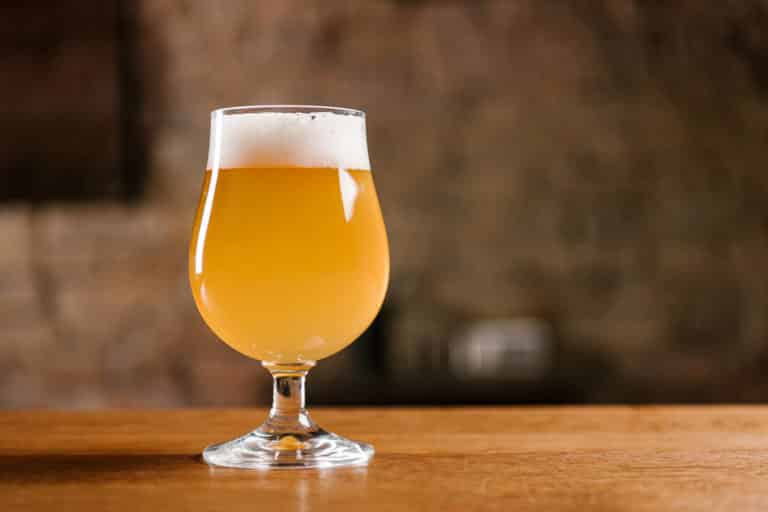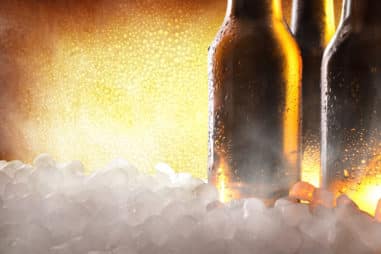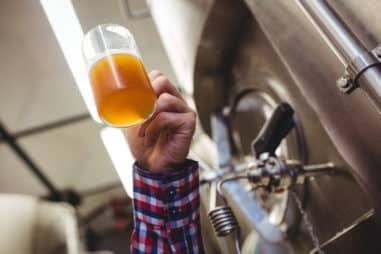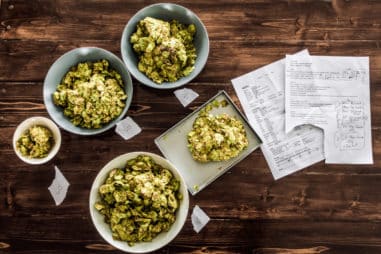IBU is a very technical topic and can get confusing and misleading. In fact, it should only be a laboratory setting. It has now become a mainstay in beer marketing through the trope: “bigger is better,” or the “Zero IBU” beer.
This article is for a brewer like you who likes to push the creative bitterness boundaries in beer. Read on to find out the dirty details of IBU and how you can make it work for you.
What Does IBU Indicate?
If you want to know how bitter your beer is, IBU will indicate that for you up to a certain point. It tries to be an objective way to estimate how bitter the beer potentially is.
But don’t get your hopes up too much, IBU values are for giving you a general sense of beer bitterness. Nevertheless, you can still maneuver the bitterness even when the IBU number of your beer is set in stone.
What Does the IBU Scale Do?
The IBU scale is nothing more than an accounting of your beer’s specific bittering compounds. The scale represents how many parts per million of the compounds are in your favorite drink.
The scale attempts to tell you how mildly bitter or painfully bitter your beverage is.
How Does the IBU Scale Work?
One IBU is equivalent to 1 part per million of isohumulone. The lower end of the scale estimates a lower bitterness for your beer and vice versa. To be clear, it does not guarantee the actual bitterness you will experience.
Isohumulone is better known as “Iso Alpha Acid” (IAA) or just alpha acid.
Do All Beers Have an IBU?
IBU is a standard specification for beer, unfortunately. You can expect an IBU number of 5 to 120 slapped on your beer’s label.
IBU being mainstream is part of a whole wobbly marketing strategy. If you look at it closely, it does not really mean anything worthwhile to the consumer, as you will soon learn.
What Is the IBU Range for Beer?
The typical IBU range of beers is 0 to 120. Below is a table of some styles for you to get a general idea.
| Beer style | IBUs |
| Lambic | 0 to 10 |
| Wheat beer | 8 to 18 |
| American lager | 8 to 26 |
| Irish red ale | 15 to 30 |
| Kölsch | 20 to 30 |
| Pilsner | 24 to 44 |
| Porter | 18 to 50 |
| Bitter | 24 to 50 |
| Pale ale | 30 to 50 |
| Stout | 30 to 90 |
| Barley wine | 34 to 120 |
| India pale ale | 40 to 120 |
What Does 20 IBU Mean in Beer?
Under a perfect IBU implementation, 20 IBU means little to no bitterness. If you added non-hop ingredients that impart bitterness, the number won’t mean anything.
Say that you added bittering herbs, that will not contribute to IBU but the beer “becomes” more bitter.
What Does IBU 200 Mean?
A value of 200 IBUs in the chart is bitter as hell, at least theoretically. This is because a brewer can balance bitterness with different ingredients. You can balance the bitterness with sugar, souring agents, or some really malty grains. It all depends on your brewing philosophy.
IBU vs. EBU
IBU is an international standard for estimating bitterness in a beer. On the other hand, EBU refers to the European Brewery Convention (EBC) Bitterness Units. Their values are virtually the same. They only differ in methodology and formulas.
When it comes to standardization, Europe does its own thing. This extends even to beer color.
IBU vs. ABV
IBU and Alcohol By Volume (ABV) are loosely related. ABV is related to the amount of sugar converted into alcohol. When the sugar conversion is not thorough, chances are you will have a background of sweet malt. This sweetness will dampen the bitter taste. A high ABV value reduces your perception of bitterness in a supposedly high IBU beer. It can, but is not always the case.
What Is the Difference Between IBU and ABV
ABV and IBU are measures of very different things from very different sources. ABV is an assessment of a beer’s strength in terms of the amount of alcohol in your beer. While IBU is an estimate of bitterness through a certain chemical in your beer that came from hops.
ABV is more intuitive than IBU because, from the angle of a consumer, most IBU predictions suck. Especially with all the flavored beers out and about.
How Many IBUs Can You Taste?
The standard IBU scale goes from 0 to 100 or 120 IBUs. This is because there is only so much bitter flavor that the common tongue can distinguish. But there aren’t really any big studies done on upper limits. The lower limit drives most of the Research.
At the end of the day, IBU is likely to be something that doesn’t improve your beer drinking experience.
What Is the Highest IBU a Human Can Taste?
IBU scales represent the most common bitter receptor upper limit of 100 to 120 IBU. Humans have highly sensitive taste receptors for the tiniest of bitter flavors. This is because, in the natural world, bitter things are commonly toxic. IBUs beyond a certain point make no sense because your instincts avoid bitter stuff.
Is IBU Related to Hoppiness?
The sad thing is, IBU can’t tell you if your beer is hoppy. With IBU, the common beer drinker believed that it talks about a beer’s hoppiness. Unfortunately, hoppiness is a mix of different stimuli you would get from brewed hops. It consists of aromas and flavors not limited to bitterness.
Hoppiness is subjective, and you cannot measure it yet, which is sad for the IBU fan.
Is Higher IBU More Hoppy?
If your beer has a ton of hops, specifically has a high IBU, but didn’t exhibit any hop character, it is not hoppy. Hoppiness is a property that includes smells and tastes that can be fruity and floral.
Moreover, you can easily game the numbers for a high IBU but get a sweet-tasting brew like a stout. All you have to do is just tweak your malts to put the bitter elements in check.
How Many IBUs Is Considered Hoppy?
IBU is not a measure of hoppiness nor first-hand bitterness. But if you insist on numbers, anything above 45 IBU is a good platform since beers here are markedly bitter. Of course, you need to disregard factors like the ingredients list and blending of the beer.
Is 30 IBU a Hoppy?
If you look at American Pale Ales, they have an IBU rating of 30 to 50 IBU. This ale has a hop flavor and aroma of moderate to strong. American Pale Ales are hoppy by design. In contrast, if you try some Sweet Stout, they overlap in 30-40 IBU, but the chocolate flavor is more prominent. Is it hoppy? It sure doesn’t smell or taste like it.
What Does a High IBU in Indicate?
A high IBU drink can say how bitter it will taste when you swig that beer, generally speaking. With so many craft beer styles nowadays, IBU doesn’t really matter beyond marketing. The brewers will balance out any nasty bitterness with a splash of flavor anyway.
Is High IBU Good?
This really depends on you, the beer patron. Have you acquired a taste for the peculiar? Will you actually enjoy the product? Are you okay with bludgeoning yourself with bitter beer? If your answer is Yes, high IBU is right for you.
And if you are the brewer, it depends on your vision for the beer or the intended impact on your target audience. If your intent is to test the breaking point of your audiences’ tongue, higher is better. If you want to experiment with ingredients that work well with pungent flavors, go ahead.
Is 60 a High IBU?
Many people will experience the higher end of the IBU scale for any value above 45 IBU. Again, it depends on the make and the blend of the beer. Take for example a Foreign Extra Stout with an IBU of 50 to 70. Tropical versions of it have bitterness on the moderate end. But if you try the export versions, they have higher bitterness. This goes to show how unreliable IBU is for the average beer-lover. Even the ranges are wide for any type of beer.
How Many IBU Is a Lot?
An IBU of 70 and above can be a lot. A bunch of “bitter” specialty IPAs works on the top end of the scale. But, don’t be surprised with stouts in this range that are on the sweet cocoa side.
What Is the Highest IBU Rating?
Once upon a time, a beer reached a rating of 2500 IBU. Props to the brewers at Ontario, Canada for their beast of a beer. They don’t sell it anymore though.
Does Higher IBU Mean More Bitter?
Bitter-tasting beer is a relative and personal feeling. Big IBU numbers on a beer that is stripped of all other flavor-adding ingredients will be more bitter. The real question is, is this bitter right for you?
What IBU Is Considered Bitter?
Try for yourself the generic point of 45 IBU and get a feel for it. Does that number really convey a fact of life? Bitter flavors are as bitter as you want them to be or are used to. Think of it as a kind of acquired taste and you’ll be fine.
Is 70 IBU Bitter?
The common description for 70 IBU beers is “medium-high to very high hop bitterness.” This description comes from beer judges of classic beer styles. Non-traditional styles will play with the values but focus on things beyond bitterness.
What Does Low IBU Mean?
Low IBU is technically the antonym of high hop bitterness. That is all there is to it until you mix in non-hop bittering agents. At that point, IBU becomes nothing more than a general direction.
What Is Considered Low IBU?
A 20 IBU beer is the perfect amount of mild to imperceptible hops. A perfect example of low IBU beer is Belgian Lambic. These are the beers that don’t really care for hops other than their preservative function.
Most low IBU beers don’t put hops on a pedestal. Since IBU is dependent on hops, IBU measurement becomes an exercise in futility.
Can a Beer Have 0 IBU?
If you happen to dislike hops, you can make a zero IBU beer. In ancient and medieval times, people used “gruit” for their bittering agent. Gruit is a combination of herbs and spices that historically used to do the job of hops. If you go for that old-school style, you can easily hit a zero.
Also, if you add hops in your wort outside of the boil, you have better chances of zero changes to IBU.
What Is an Average IBU?
Average IBUs tend to be in the 20 to 45 range. But it depends on what the average person drinks. The top-grossing beer is Bud Light with an IBU of 10. Now that sounds like a nice average.
What Is a Good IBU?
Since Bud Light, a Light Lager around 10 IBU, you can conjecture that it is a good IBU. Not so bitter with good enough hoppiness. Just the right balance.
It is a clear statistical winner. You may hate it, but the people have spoken.
How Do Breweries Measure IBU?
Small breweries use the UV spectrophotometric assay for its ease of use. Bigger breweries use High-Pressure Liquid Chromatography. If all that is outside of a brewery’s budget, trained panelists are good enough.
How Do You Measure IBU in Beer?
If you are a small brewer, UV spectrophotometry is your best choice. Trained panelists are good as well but it depends on what you value. If you want to focus on quality control and consistency, go for spectrophotometry. If you value customer satisfaction, focus groups are worth the effort.
As a bonus, below is the general idea of UV spectrophotometry for the scientists out there:
- Take out your samples of beer.
- Place them in vials.
- Pour in carefully some hydrochloric acid.
- Pour in carefully an organic solvent.
- The isohumulones will gravitate to the solvent.
- Separate the emulsion formed and draw off the solvent into your cuvette.
- Pass a beam of 275 nanometer-wavelength light.
- Measure the absorbance and calculate the IBU.
How to Calculate IBU Beer
There are two ways to calculate IBU. First, after doing the spectrophotometry, multiply the absorbance by a factor of 50. Simple and easy, for a scientist, that is.
Second, if you want to make a quick estimate, try this empirical formula from Fred Eckhardt. By the way, he is the pioneer of beer journalism.
- IBU = the Sum of Ounces of Hops multiplied by the Alpha Acid Content of the Hops multiplied by the % Hops Utilization divided by a constant 7.25.
- IBU = Σ [(Ounce of Hops) x (% Alpha Acid) x (% Hops Utilization)] ÷ 7.25
Below is a table of Hops Utilization for the above formula:
| Hops Utilization, % | Boil Time |
| 31.0% | over 60 Minutes |
| 30.0% | 51 to 60 Minutes |
| 28.1% | 46 to 50 Minutes |
| 26.9% | 45 to 41 Minutes |
| 22.8% | 40 to 36 Minutes |
| 18.8% | 31 to 35 Minutes |
| 15.3% | 26 to 30 Minutes |
| 12.1% | 21 to 25 Minutes |
| 10.1% | 16 to 20 Minutes |
| 08.0% | 11 to 15 Minutes |
| 06.0% | 6 to 10 Minutes |
| 05.0% | Up to 5 Minutes |
There are other estimation formulas available but are non-trivial. You should use online calculators to make your life easier. The math can turn ugly real fast.
What Affects IBU?
What affects IBU by value are the boiling parameters of hops, and diluting your beer in any way. Stuff that affects IBU by quality is on quite a long list:
- Water Chemistry
- Intensity of Grain Roast
- Unconverted Sugars
- Secondary Hop Chemicals
- Herbs and Spices
- Sweeteners (Artificial or Natural Juices, Fruits)
- Carbonation
How to Increase IBU in Beer
If you boil hops for longer, you release more of the primary bittering compounds. Adding more hops per liter of wort increases alpha acid availability in the product. Increasing the number of stages when you add hops works wonders for the numbers. It is a simple numbers game when you think about it.
How to Lower IBU in Beer
The opposite is true for lowering IBU values. Reducing the hops quantities and boiling times work to lower IBU. Furthermore, increasing your gallonage with water or juice reduces bittering compound concentrations. You can even try blending with lower IBU beers.
Does Dry Hopping Add to IBU?
There is not enough research about dry hopping and IBU. People previously believed that dry hopping adds bitterness to beer without raising IBU. New research has surfaced showing increased IBU from doing this method. It is a deal-breaker for Zero IBU products that rely on dry hopping.
How Does Dry Hopping Affect IBU?
Hops have secondary bittering compounds that are not measured in the IBU method. These compounds enable dry hopping to affect IBU qualitatively. You release these compounds without the need for boiling, simply soaking is enough. They also get more bitter over time thanks to oxidation.
You do dry hopping by adding hops during the fermentation or conditioning phase. Doing so avoids the release of primary bittering chemicals measured by IBU. It is basically a hop hack.
How to Calculate IBU When Dry Hopping?
Sadly, you cannot calculate IBU when dry hopping because it does not definitively add to IBU. Research is ongoing to refute this belief. The only way to come up with an IBU value is through experimentation. Or, just wait for the scientists to figure it out.








